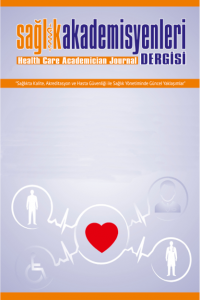OTOİMMÜN TİROİDİTİ OLAN HASTALARDA PREMATÜR OVARYAN YETMEZLİK SIKLIĞI
Prematür over yetmezliği, Anti-Müllerian hormon, Otoimmün Tiroidit, Anti-TPO, Anti-TG.
PREVALENCE OF PREMATURE OVARIAN FAILURE IN PATIENTS WITH AUTOIMMUNE THYROIDITIS
Premature ovarian failure, Anti-Müllerian hormone, Autoimmune Thyroiditis, Anti-TPO, Anti-TG.,
___
- 1. Nelson LM. (2009) Clinical practice. Primary ovarian insufficiency. N Engl J Med, 360(6):606–14.
- 2. De Vos M, Devroey P, Fauser BCJM (2010). Primary ovarian insufficiency. Lancet (London, England), 376(9744):911–21.
- 3. Nelson SM, Iliodromiti S, Fleming R, Anderson R, McConnachie A, Messow C-M. (2014) Reference range for the antimüllerian hormone Generation II assay: a population study of 10,984 women, with comparison to the established Diagnostics Systems Laboratory nomogram. Fertil Steril, 101(2):523–9.
- 4. Michalakis KG, Mesen TB, Brayboy LM. (2011) Subclinical elevations of thyroid-stimulating hormone and assisted reproductive technology outcomes. Fertil Steril, 95(8):2634–7.
- 5. Weetman AP. (2021) An update on the pathogenesis of Hashimoto’s thyroiditis. J Endocrinol Invest, 44(5):883–90.
- 6. Allam MM, El-Zawawy HT, Barakat SS, Ahmed SM, Saleh RNM. (2020) A hidden cause of infertility in hypothyroid patients. Clinical case reports, 8:374–8.
- 7. Rodríguez-Castelán J, Anaya-Hernández A, Méndez-Tepepa M, Martínez-Gómez M, Castelán F, Cuevas-Romero E (2017) Distribution of thyroid hormone and thyrotropin receptors in reproductive tissues of adult female rabbits. Endocr Res, 42(1):59–70.
- 8. Meng L, Rijntjes E, Swarts HJM, Keijer J, Teerds KJ. (2017) Prolonged hypothyroidism severely reduces ovarian follicular reserve in adult rats. J Ovarian Res, 10(1):1–8.
- 9. Colella M, Cuomo D, Giacco A, Mallardo M, De Felice M, Ambrosino C. (2020) Thyroid Hormones and Functional Ovarian Reserve: Systemic vs. Peripheral Dysfunctions. J Clin Med, 9(6):31–6.
- 10. Goswami R, Marwaha RK, Goswami D. (2006) Prevalence of thyroid autoimmunity in sporadic idiopathic hypoparathyroidism in comparison to type 1 diabetes and premature ovarian failure. J Clin Endocrinol Metab, 91(11):4256–9.
- 11. La Marca A, Sighinolfi G, Radi D. (2010) Anti-Mullerian hormone (AMH) as a predictive marker in assisted reproductive technology (ART). Hum Reprod Update, 16(2):113–30.
- 12. Bahri S, Tehrani FR, Amouzgar A. (2019) Overtime trend of thyroid hormones and thyroid autoimmunity and ovarian reserve: a longitudinal population study with a 12-year follow up. BMC Endocr Disord, 19(1):47.
- 13. Polyzos NP, Sakkas E, Vaiarelli A, Poppe K, Camus M, Tournaye H. (2015) Thyroid autoimmunity, hypothyroidism and ovarian reserve: a cross-sectional study of 5000 women based on age-specific AMH values. Hum Reprod, 30(7):1690–6.
- 14. Coulter B (2017). Anti-Müllerian hormone, Access Use, Instructions For Useitle. 11/04/2020 https://www.beckmancoulter.com/wsrportal/techdocs?docname=/cis/b15676/a/Access AMH_B15676-A_English.pdf
- 15. BRAHMS (2021). Thyroid Markers for Diseases in Endocrinology. 11/04/2020 https://www.brahms.de/en-gb/products/endocrinology.html
- 16. Alexander EK, Pearce EN, Brent GA. (2017) Guidelines of the American Thyroid Association for the Diagnosis and Management of Thyroid Disease During Pregnancy and the Postpartum. Thyroid, 27(3):315–89.
- 17. Morales-Martínez FA, Sordia-Hernández LH, Ruiz MM, Garcia-Luna S, Valdés-Martínez OH, Vidal-Gutierez O. (2021) Association between thyroid autoimmunity and ovarian reserve in women with hypothyroidism. Thyroid Res, 14(1):6.
- 18. Krassas GE, Poppe K, Glinoer D. (2021) Thyroid function and human reproductive health. Endocr Rev, 31(5):702–55.
- 19. Gawlik A, Malecka-Tendera E. (2014) Transition In Endocrinology: Treatment of Turner’s syndrome during transition. Eur J Endocrinol, 170(2):R57–74.
- 20. Grossi A, Crinò A, Luciano R, Lombardo A, Cappa M, Fierabracci A. (2013) Endocrine autoimmunity in Turner syndrome. Ital J Pediatr, 39:79.
- 21. Fukuda I, Hizuka N, Kurimoto M. (2009) Autoimmune thyroid diseases in 65 Japanese women with Turner syndrome. Endocr J, 56(8):983–6.
- 22. Monteleone P, Parrini D, Faviana P (2011) Female infertility related to thyroid autoimmunity: the ovarian follicle hypothesis. Am J Reprod Immunol, 66(2):108–14.
- 23. Saglam F, Onal ED, Ersoy R. (2015) Anti-Müllerian hormone as a marker of premature ovarian aging in autoimmune thyroid disease. Gynecol Endocrinol, 31(2):165–8.
- 24. Chen C-W, Huang Y-L, Tzeng C-R, Huang R-L, Chen C-H. (2017) Idiopathic low ovarian reserve is associated with more frequent positive thyroid peroxidase antibodies. Thyroid, 27(9):1194–200.
- 25. Ke H, Hu J, Zhao L, Ding L, Jiao X, Qin Y. (2020) Impact of thyroid autoimmunity on ovarian reserve, pregnancy outcomes, and offspring health in euthyroid women following in vitro fertilization/intracytoplasmic sperm injection. Thyroid, 30(4):588–97.
- 26. Osuka S, Iwase A, Goto M (2018). Thyroid autoantibodies do not impair the ovarian reserve in euthyroid infertile women: a cross-sectional study. Horm Metab Res, 50(07):537–42.
- 27. Kuroda M, Kuroda K (2018) Levothyroxine supplementation improves serum anti‐Müllerian hormone levels in infertile patients with Hashimoto’s thyroiditis. J Obstet Gynaecol Res, 44(4):739–46.
- 28. Fanchin R, Taieb J, Lozano DHM, Ducot B, Frydman R, Bouyer J. (2005) High reproducibility of serum anti-Müllerian hormone measurements suggests a multi-staged follicular secretion and strengthens its role in the assessment of ovarian follicular status. Hum Reprod, 20(4):923–7.
- 29. Moslehi N, Shab-Bidar S, Tehrani FR, Mirmiran P, Azizi F. (2018) Is ovarian reserve associated with body mass index and obesity in reproductive aged women? A meta-analysis. Menopause, 25(9):1046–55.
- 30. Hollowell JG, Staehling NW, Flanders WD (2002). Serum TSH, T(4), and thyroid antibodies in the United States population (1988 to 1994): National Health and Nutrition Examination Survey (NHANES III). J Clin Endocrinol Metab, 87(2):489–99.
- ISSN: 2148-7472
- Yayın Aralığı: Yılda 4 Sayı
- Başlangıç: 2014
- Yayıncı: Dünya Kongre
OBSTETRİDE VE JİNEKOLOJİDE APİTERAPİNİN KULLANIMI
Shaira . RAHİMJANOVA, Hüsniye DİNÇ, Sevil GÜNAYDIN
ÖDEME GÜÇLÜĞÜNE BAĞLI KARŞILANAMAYAN TIBBİ BAKIM İHTİYACI
Melek TERZİ, Mehmet Nurullah KURUTKAN, Dilek ŞAHİN, Oğuz KARA
Sağlıkta “4P tıbbı”: Geleneksel tıp tarih mi oluyor?
Tuğçe ÇAMLICA, Fatma ETİ ASLAN
Anemide Gebelik Sonuçları ve Bakım
Sağlık Kurulunda Çalışanların İletişim Sorunları ve Çözüm Önerileri Üzerine Nitel Bir Araştırma
Nilay GEMLİK, Rukiye ŞEKER, Ali ARSLANOĞLU, Özgür ÇENGEL
Esin TEMELOĞLU ŞEN, H. Özlem SERTEL BERK, Dilsad SİNDEL
OTOİMMÜN TİROİDİTİ OLAN HASTALARDA PREMATÜR OVARYAN YETMEZLİK SIKLIĞI
Ceren YILDIZ EREN, Hulusi Göktuğ GÜRER, Özlem ÖZGÜR GÜRSOY, Ozge GODEK
TOPLUMUN SAĞLIK ÇALIŞANLARINA YÖNELİK ŞİDDET KONUSUNDAKİ TUTUMU
Seda ÜNAL, Emel FİLİZ, Şeyma KAHVECİ, Sultan UYAR
Atikullah GHİASEE, Merve KARAKAŞ
